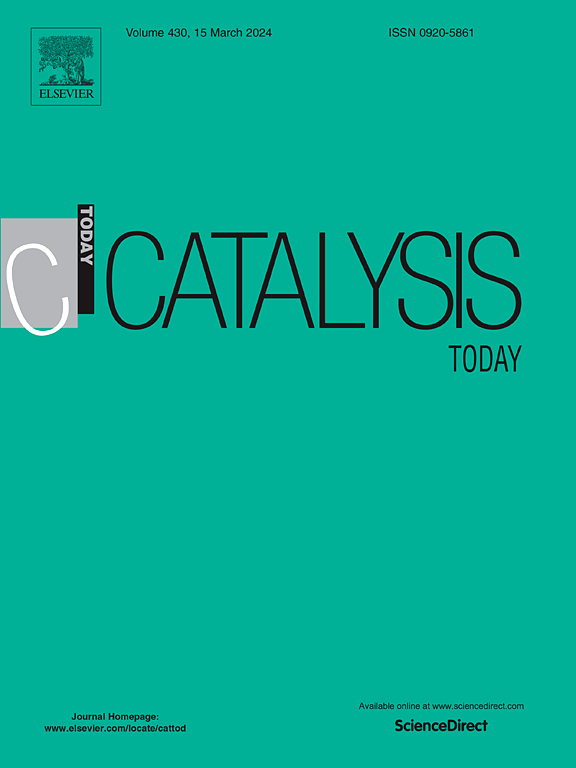Isothermal conversion of methane to methanol over Cu-CHA using different oxidants
IF 5.2
2区 化学
Q1 CHEMISTRY, APPLIED
引用次数: 0
Abstract
Methane oxidation to methanol in cyclic processes using CuO-zeolites has traditionally employed O2 and N2O as oxidants. This study explores the use of Cu-CHA zeolite, demonstrating that CO2 can substitute O2 in an isothermal reaction at 400 °C, analogous to previous findings using Cu-MAZ. The use of in situ UV-Vis diffuse reflectance spectroscopy (UV-Vis DRS) and density functional theory (DFT) theoretical calculations identified the formation of a binuclear copper hydroxide complex, Z-[CuOH-HOCu]2+-Z, on the Cu-CHA. Initial treatment using CO2 led to marginally superior catalytic activity, compared to the use of O2 alone, indicating the stability of the Z-[CuOH-HOCu]2+-Z complex against self-reduction at 400 °C. In subsequent cycles, activation with O2 facilitated the oxidation of adsorbed methanol, yielding water and reconstituting the active sites. Conversely, activation with CO2 led to the partial desorption of methanol, precluding water production and subsequent catalyst regeneration. The findings suggested that both O2 and CO2 activations necessitated a post-reaction water extraction step, followed by thermal treatment to replenish the active sites. Importantly, the results indicated that CO2 could be used as a viable alternative oxidant to O2 in this catalytic process, potentially enhancing the sustainability of industrial methanol production.
使用不同氧化剂在 Cu-CHA 上将甲烷等温转化为甲醇
在使用 CuO-zeolites 的循环过程中,甲烷氧化成甲醇的过程传统上使用 O2 和 N2O 作为氧化剂。本研究探索了 Cu-CHA 沸石的使用,证明在 400 °C 的等温反应中 CO2 可以替代 O2,这与之前使用 Cu-MAZ 的研究结果类似。利用原位紫外可见光漫反射光谱(UV-Vis DRS)和密度泛函理论(DFT)理论计算确定了在 Cu-CHA 上形成的双核氢氧化铜复合物 Z-[CuOH-HOCu]2+-Z。与单独使用 O2 相比,使用 CO2 进行初始处理可略微提高催化活性,这表明 Z-[CuOH-HOCu]2+-Z 复合物在 400 °C 温度下具有抗自还原的稳定性。在随后的循环中,用 O2 活化可促进吸附的甲醇氧化,生成水并重组活性位点。相反,用 CO2 激活则会导致部分甲醇解吸,从而排除水的生成和催化剂的后续再生。研究结果表明,氧气和二氧化碳活化都需要在反应后进行水提取步骤,然后再进行热处理以补充活性位点。重要的是,研究结果表明,在这一催化过程中,二氧化碳可用作氧气的替代氧化剂,从而有可能提高工业甲醇生产的可持续性。
本文章由计算机程序翻译,如有差异,请以英文原文为准。
求助全文
约1分钟内获得全文
求助全文
来源期刊

Catalysis Today
化学-工程:化工
CiteScore
11.50
自引率
3.80%
发文量
573
审稿时长
2.9 months
期刊介绍:
Catalysis Today focuses on the rapid publication of original invited papers devoted to currently important topics in catalysis and related subjects. The journal only publishes special issues (Proposing a Catalysis Today Special Issue), each of which is supervised by Guest Editors who recruit individual papers and oversee the peer review process. Catalysis Today offers researchers in the field of catalysis in-depth overviews of topical issues.
Both fundamental and applied aspects of catalysis are covered. Subjects such as catalysis of immobilized organometallic and biocatalytic systems are welcome. Subjects related to catalysis such as experimental techniques, adsorption, process technology, synthesis, in situ characterization, computational, theoretical modeling, imaging and others are included if there is a clear relationship to catalysis.
 求助内容:
求助内容: 应助结果提醒方式:
应助结果提醒方式:


